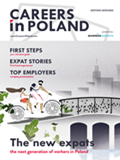How do students in Poland search for their first job?

Editor

Photo by Bethany Legg on Unsplash
related articles
related offers
The MBE Group 2024 report, “A po studiach idziemy do pracy” (eng. And After Graduation, We Go to Work), might provide some interesting insights – whether you're a student searching for that elusive first gig or an employer wondering how to attract the brightest young minds. The report, conducted in 2024 on a sample of 954 students using the CAWI method, reveals what is important to them when choosing an employer. Let’s dive in.
Students in Poland – Small town, big city, or the daily commute?
Let’s start with the basics. The report indicates that a whopping 42% of students don’t live in the cities where they study, thanks to Poland’s major university hubs being concentrated in big cities. Many of these students hail from small towns (71% of them from areas with populations under 50,000).
For employers, this trend is a golden nugget of wisdom: many potential candidates live outside urban centers. So, crafting recruitment strategies to include hybrid or remote options can make your job offers more enticing than a freshly brewed cup of coffee during exam week.
How do students in Poland look for jobs?
Let’s face it: the days when students circled job ads in newspapers are long gone. According to the report, today’s savvy job-seekers turn to:
- Job boards (45%): Despite the growing role of social media, job boards still remain the one of the most popular means of connecting candidates with employers. Therefore, if your company’s profiles aren’t engaging and up-to-date, you're leaving money – and potential talent – on the table.
- Facebook groups (43%): Yes, Facebook is alive and kicking, at least in the realm of job hunting.
- Friends and family recommendations (43%): Sometimes, it’s not just what you know but who you know – or who your cousin knows?
- Career offices (31%) and specialized portals (29%): These are particularly efficient when looking for more niche roles.
Pro-tip for employers:
When planning online activities, it is worth diversifying the outreach channels. A strong campaign concentrated on a single medium might not be enough. By leveraging the potential of varied traffic sources, we can tell different parts of our story across various platforms, making our message more engaging and comprehensive.
Moreover, ensure your job postings include a job description and a sneak peek into your company culture. Throw in some photos of your team enjoying their lunch breaks or competing at ping-pong tournaments – whatever showcases your company culture and spirit.
What makes a job offer attractive?
It’s no surprise that salary tops the list (78% of students say it’s their key focus). But the report indicates that the students also appreciate:
- Flexible schedules (61%): Nowadays, students want to balance work with their studies, so a rigid 9-to-5 probably won’t cut it.
- Opportunities for skill-building (56%): As young professionals at the beginning of their career oath, students are looking for experience that boosts their career prospects.
- Convenient location (54%): Because who doesn’t love commuting for hours?
Students also appreciate remote work options (46%) and clear career paths (44%). On the flip side, company perks and prestige rank surprisingly low on their wish lists, proving that simplicity and practicality reign supreme.
How can employers meet students where they are?
To connect with students, both online and offline strategies can work wonders:
- Workshops on campus (74% find them attractive, 42% declare participation): These venues seem to be student favorites. Particularly so if the workshop offers real-world skills or industry insights.
- Independent workshops (68% attractive, 30% participation): As in the previous case, it seems that students appreciate initiatives related to enhancing their competence and development in a given field.
- Company-organized events on campus (65% attractive, 30% participation): A stand on a job fairs or even casual Q&A sessions might help bridge the breach between a company and a student looking for employment.
Worth noting: Students seem to like career fairs, but their attendance is lower than their interest. Employers and universities should take note to promote these events better, and you might see that participation rate soar!
Job ads and the power of transparency
With information and possibilities readily available, today’s students are becoming increasingly discerning. Over 51% expect salary ranges to be included in job offers. They also look for:
-
Proximity to their current location (61%).
- Employee testimonials (55%) to understand workplace culture.
This means a clear, honest, and student-friendly communication strategy is key for employers. Want to impress your audience? Feature real stories from your team, show off your workspace, and, preferably, disclose their salary range, for a change.












